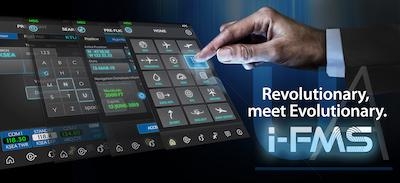Wed, Jun 19, 2019
Offers Innovative Pilot Interface To Support Full Augmentation Between Wearable/Head-Up Displays & Flight Deck
Universal Avionics (UA) has introduced the ClearVision Interactive-FMS (i-FMS), a software-based FMS designed to be an end-supplier solution for flight management in an Integrated Modular Avionics (IMA) infrastructure. The i-FMS offers the latest in Human-Machine Interface (HMI) by augmenting Head-Up Displays (HUD) and Head-Wearable Displays (HWD) to the flight deck itself, allowing pilots to ‘fly-by-sight.’ Certification is expected during the second half of 2020.

Built from the ground-up by a company with decades of flight management experience, the i-FMS tackles one of the main challenges pilots face today with FMS operations; the need to propose changes to the FMS during critical phases of flight such as takeoff and landing. Typically, during this time pilots are required to shift their attention from outside the cockpit window to the FMS display unit – to reprogram the FMS and validate changes are correct – requiring last-minute updates and head-down operations. The i-FMS better supports this, allowing pilots to project waypoints and information from the FMS onto the real-world, superimposed on a HUD or UA’s SkyLens HWD. Pilots are able to interact with these features by Line-of-Sight (head/eye tracking) and a select/deselect button on the aircraft yoke or throttle.
“Market trends are moving in the direction of software-based FMSs rather than hardware, as they offer users a more flexible and open architecture system,” said Dror Yahav, UA CEO. “The i-FMS software can run on a variety of hardware options – for commercial or paramilitary applications,” he added. “New, innovative interfaces, augmented to the real world utilizing HUD technology is where we believe the market is heading. It’s the future of flying and we’re seeing a high level of interest in it. What really distinguishes our i-FMS solution is that we designed it to support flying by sight. It will simplify avionics and eliminate many of the current pain points in pilot interfaces.”
The i-FMS features a portable FMS with highly modular architecture for ready deployment to any ARINC 653 compliant platform and a separate Human Machine Interface (HMI). The ARINC 653 compliant system allows customers to run the application in many third-party options to best suit their flight deck, with no need for specific hardware or Line Replaceable Units (LRU). The HMI, implemented with an ARINC 661 User Application, connects to the core operating system and allows pilots to communicate with the application. With UA’s easy-to-use, customizable HMI, customers can design their own flight deck with the hosted FMS software.
Since the system is modular, customers may specify future functionalities, allowing for easy adaptation to address upcoming requirements. Support for a third-party HMI is also offered. Additionally, customers may integrate their proprietary functions by interfacing to the core operating system or by customizing menus and operational logic.
(Image provided with Universal Avionics news release)
More News
Aero Linx: Model Aeronautical Association of Australia MAAA clubs are about fun flying, camaraderie and community. For over 75 years, the MAAA has been Australia’s largest fl>[...]
Touchdown Zone Lighting Two rows of transverse light bars located symmetrically about the runway centerline normally at 100 foot intervals. The basic system extends 3,000 feet alon>[...]
“Discovery and innovation are central to our mission at Virgin Galactic. We’re excited to build on our successful record of facilitating scientific experiments in subor>[...]
How To Get A Story On Aero-TV News/Feature Programming How do I submit a story idea or lead to Aero-TV? If you would like to submit a story idea or lead, please contact Jim Campbel>[...]
Student Pilot Reported That During Rotation, “All Of A Sudden The Back Of The Plane Kicked To The Right..." Analysis: The student pilot reported that during rotation, “>[...]
 ANN's Daily Aero-Linx (05.02.24)
ANN's Daily Aero-Linx (05.02.24) ANN's Daily Aero-Term (05.02.24): Touchdown Zone Lighting
ANN's Daily Aero-Term (05.02.24): Touchdown Zone Lighting Aero-News: Quote of the Day (05.02.24)
Aero-News: Quote of the Day (05.02.24) ANN FAQ: Contributing To Aero-TV
ANN FAQ: Contributing To Aero-TV NTSB Final Report: Cirrus Design Corp SR20
NTSB Final Report: Cirrus Design Corp SR20



